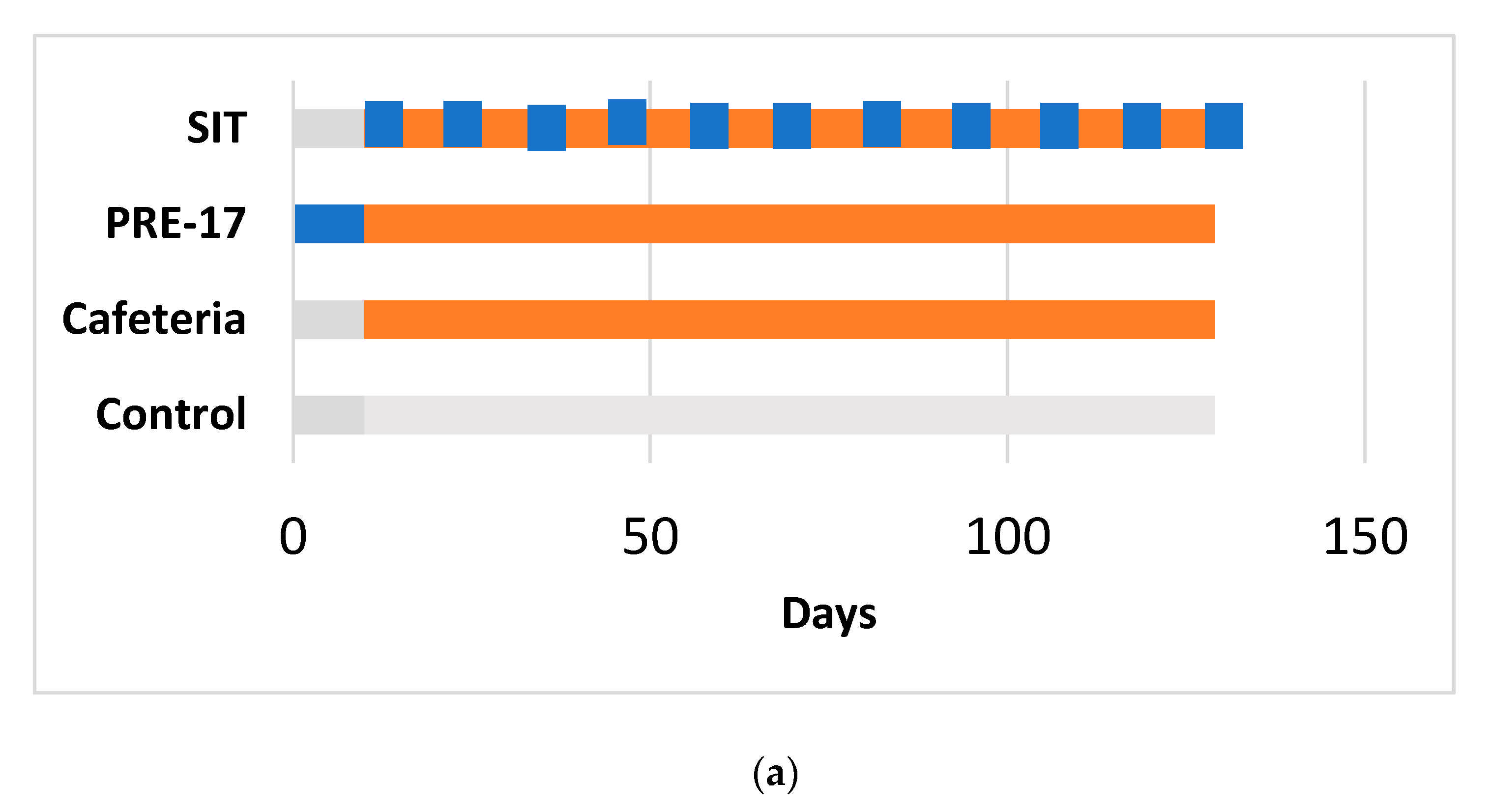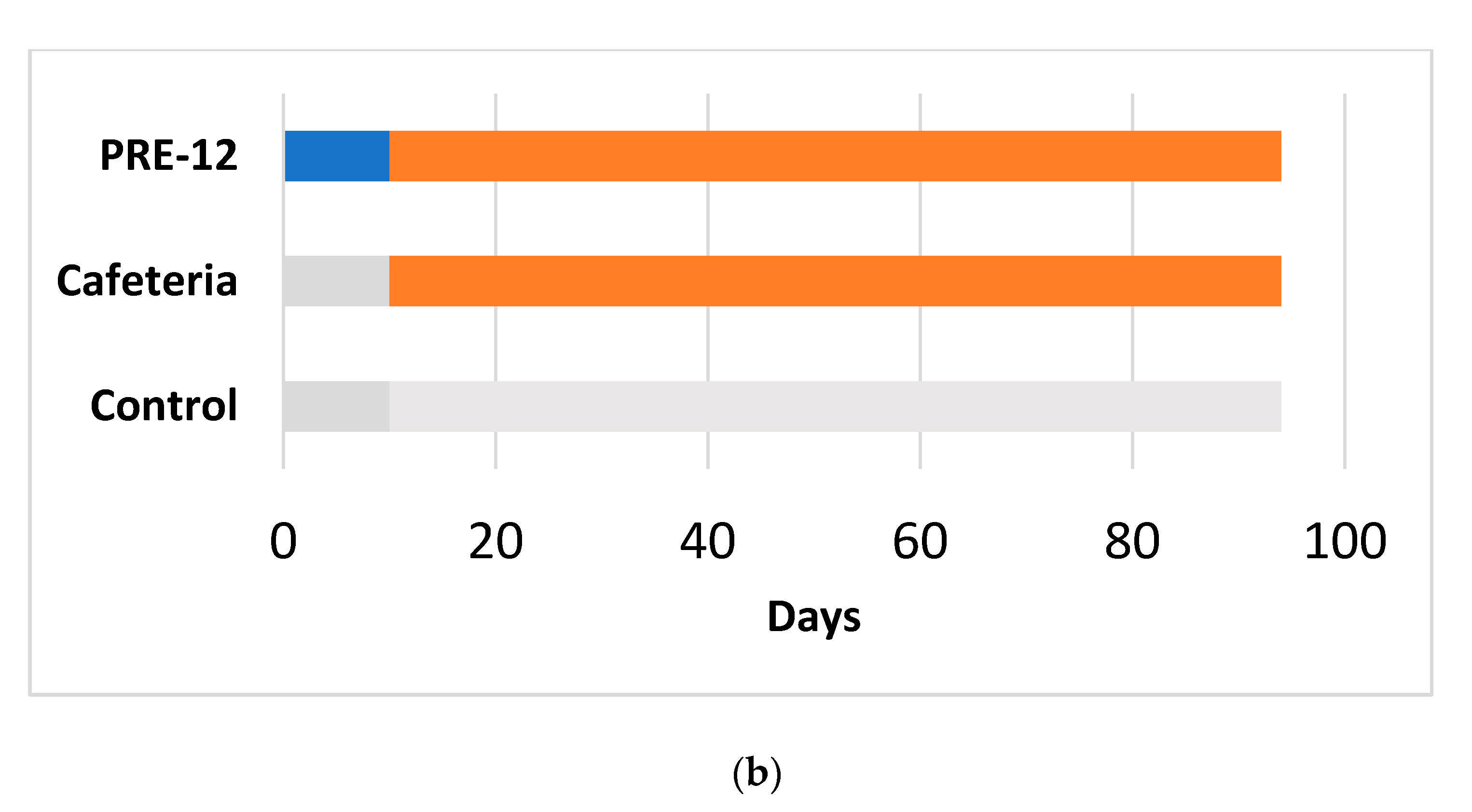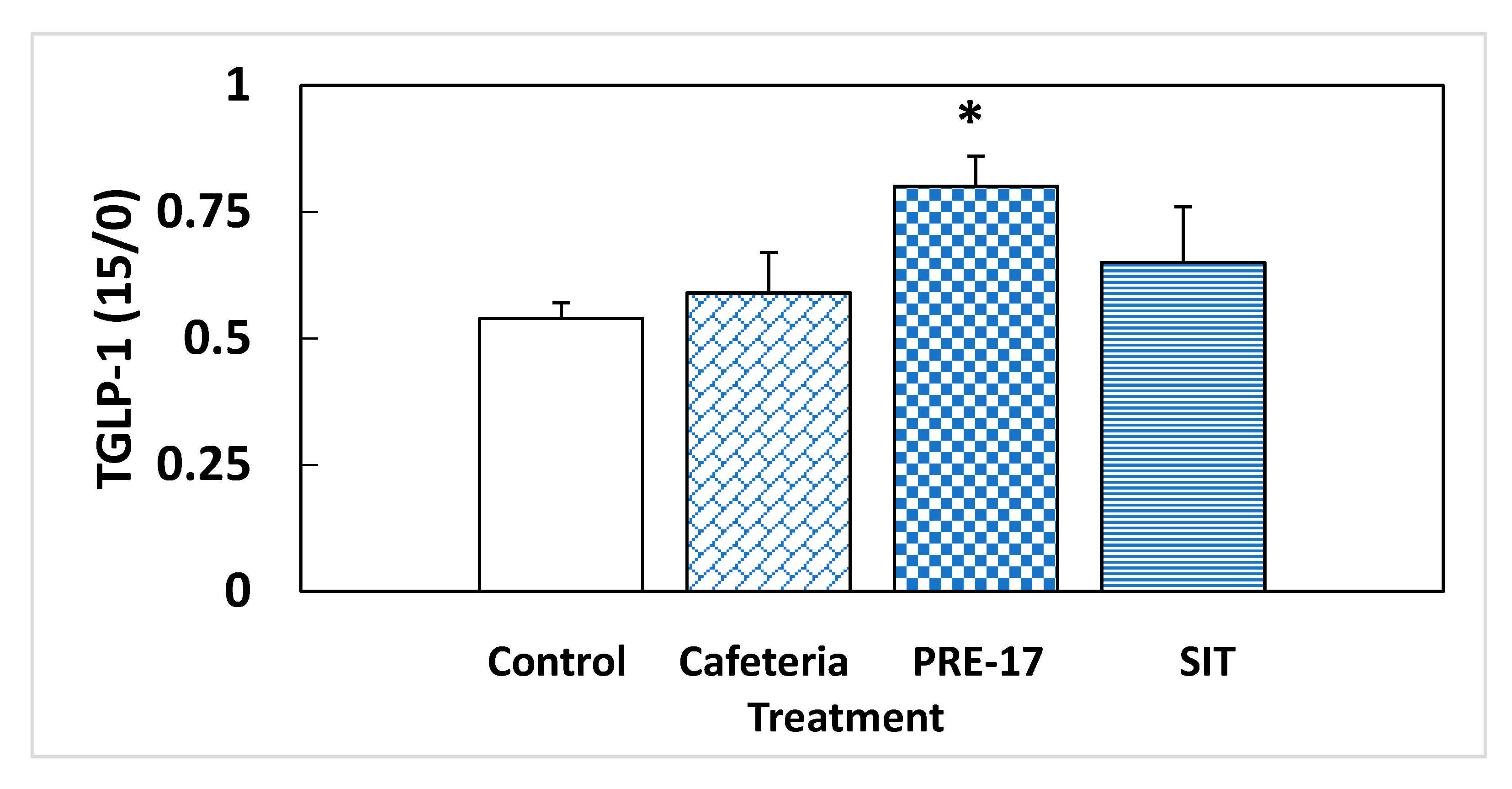Glucagon Shows Higher Sensitivity than Insulin to Grapeseed Proanthocyanidin Extract (GSPE) Treatment in Cafeteria-Fed Rats
Abstract
1. Introduction
2. Materials and Methods
2.1. Proanthocyanidin Extract
2.2. Animal Experiments
2.3. Plasma and Tissue Hormone Analysis
2.4. Quantitative Real-Time RT-PCR Analysis
2.5. Statistical Analysis
3. Results and Discussion
3.1. Glucagonemia Remains Sensitive to GSPE Treatment Several Weeks after the Treatment Has Finished
3.2. Pre-Treatment with GSPE Might Increase GLP-1 Sensitivity in the Pancreas
3.3. Administration of GSPE Simultaneously to a Cafeteria Diet Produces Effects on the Endocrine Pancreas That Are Different to the Preventive Approach
4. Conclusions
Supplementary Materials
Author Contributions
Funding
Institutional Review Board Statement
Informed Consent Statement
Data Availability Statement
Acknowledgments
Conflicts of Interest
References
- Walker, J.N.; Ramracheya, R.; Zhang, Q.; Johnson, P.R.V.; Braun, M.; Rorsman, P. Regulation of glucagon secretion by glucose: Paracrine intrinsic or both? Diabetes Obes. Metab. 2011, 13, 95–105. [Google Scholar] [CrossRef] [PubMed]
- Kahn, S.E.; Zraika, S.; Utzschneider, K.M.; Hull, R.L. The Beta cell lesion in type 2 Diabetes: There has to be a primary functional abnormality. Diabetologia 2009, 52, 1003–1012. [Google Scholar] [CrossRef] [PubMed]
- Dunning, B.E.; Foley, J.E.; Ahrén, B. Alpha cell function in health and disease: Influence of glucagon-like peptide-1. Diabetologia 2005, 48, 1700–1713. [Google Scholar] [CrossRef] [PubMed]
- Holst, J.J. The physiology of glucagon-like peptide 1. Physiol. Rev. 2007, 87, 1409–1439. [Google Scholar] [CrossRef]
- Drucker, D.J. Minireview: The Glucagon-like peptides. Endocrinology 2001, 142, 521–527. [Google Scholar] [CrossRef]
- Xu, G.; Kaneto, H.; Laybutt, D.R.; Duvivier-Kali, V.F.; Trivedi, N.; Suzuma, K.; King, G.L.; Weir, G.C.; Bonner-Weir, S. Downregulation of GLP-1 and GIP receptor expression by hyperglycemia: Possible contribution to impaired incretin effects in diabetes. Diabetes 2007, 56, 1551–1558. [Google Scholar] [CrossRef]
- Hare, K.J.; Knop, F.K.; Asmar, M.; Madsbad, S.; Deacon, C.F.; Holst, J.J.; Vilsbøll, T. Preserved inhibitory potency of GLP-1 on glucagon secretion in type 2 diabetes mellitus. J. Clin. Endocrinol. Metab. 2009, 94, 4679–4687. [Google Scholar] [CrossRef]
- Quesada, I.; Tudurí, E.; Ripoll, C.; Nadal, Á. Physiology of the pancreatic α-cell and glucagon secretion: Role in glucose homeostasis and diabetes. J. Endocrinol. 2008, 199, 5–19. [Google Scholar] [CrossRef]
- Conarello, S.L.; Jiang, G.; Mu, J.; Li, Z.; Woods, J.; Zycband, E.; Ronan, J.; Liu, F.; Roy, R.S.; Zhu, L.; et al. Glucagon receptor knockout mice are resistant to diet-induced obesity and streptozotocin-mediated beta cell loss and hyperglycaemia. Diabetologia 2007, 50, 142–150. [Google Scholar] [CrossRef]
- He, M.; Su, H.; Gao, W.; Johansson, S.M.; Liu, Q.; Wu, X.; Liao, J.; Young, A.A.; Bartfai, T.; Wang, M.W. Reversal of obesity and insulin resistance by a non–peptidic glucagon-like peptide-1 receptor agonist in diet-induced obese mice. PLoS ONE 2010, 5. [Google Scholar] [CrossRef]
- González-Abuín, N.; Martínez-Micaelo, N.; Margalef, M.; Blay, M.; Arola-Arnal, A.; Muguerza, B.B.; Ardévol, A.; Pinent, M.; Gonzalez-Abuin, N.; Martinez-Micaelo, N.; et al. A grape seed extract increases active glucagon-like peptide-1 levels after an oral glucose load in rats. Food Funct. 2014, 5, 2357–2364. [Google Scholar] [CrossRef]
- González-Abuín, N.; Martínez-Micaelo, N.; Blay, M.; Ardévol, A.; Pinent, M.; Gonzalez-Abuin, N.; González-Abuín, N.; Martínez-Micaelo, N.; Blay, M.; Ardévol, A.; et al. Grape-Seed Procyanidins Prevent the Cafeteria-Diet-Induced Decrease of Glucagon-Like Peptide-1 Production. J. Agric. Food Chem. 2014, 62, 1066–1072. [Google Scholar] [CrossRef]
- Ginés, I.; Gil-Cardoso, K.; D’addario, C.; Falconi, A.; Bellia, F.; Blay, M.T.; Terra, X.; Ardévol, A.; Pinent, M.; Beltrán-Debón, R. Long-lasting effects of gspe on ileal GLP-1R gene expression are associated with a hypomethylation of the GLP-1R promoter in female wistar rats. Biomolecules 2019, 9, 865. [Google Scholar] [CrossRef]
- Castell-Auvi, A.; Cedo, L.; Pallares, V.; Blay, M.; Pinent, M.; Ardevol, A.; Castell-Auví, A.; Cedó, L.; Pallarès, V.; Blay, M.; et al. Grape seed procyanidins improve β-cell functionality under lipotoxic conditions due to their lipid-lowering effect. J. Nutr. Biochem. 2013, 24, 948–953. [Google Scholar] [CrossRef]
- Ginés, I.; Gil-Cardoso, K.; Serrano, J.; Casanova-Martí, À.; Blay, M.; Pinent, M.; Ardévol, A.; Terra, X. Effects of an Intermittent Grape-Seed Proanthocyanidin (GSPE) Treatment on a Cafeteria Diet Obesogenic Challenge in Rats. Nutrients 2018, 10, 15. [Google Scholar] [CrossRef]
- Ginés, I.; Gil-Cardoso, K.; Terra, X.; Blay, M.; Pérez-Vendrell, A.M.; Pinent, M.; Ardévol, A. Grape Seed Proanthocyanidins Target the Enteroendocrine System in Cafeteria-Diet-Fed Rats. Mol. Nutr. Food Res. 2019, 63, 1800912. [Google Scholar] [CrossRef]
- Castell-Auví, A.; Cedó, L.; Pallarès, V.; Blay, M.; Ardévol, A.; Pinent, M. The effects of a cafeteria diet on insulin production and clearance in rats. Br. J. Nutr. 2012, 108, 1155–1162. [Google Scholar] [CrossRef]
- Lan, P.; Solveig, H.; Li, H.; Ning, X. Effects of different diets used in diet-induced obesity models on insulin resistance and vascular dysfunction in C57BL/6 mice. Sci. Rep. 2019, 9, 19556. [Google Scholar]
- Dusaulcy, R.; Handgraaf, S.; Skarupelova, S.; Visentin, F.; Vesin, C.; Heddad-masson, M.; Reimann, F.; Gribble, F.; Philippe, J.; Gosmain, Y. Functional and Molecular Adaptations of Enteroendocrine L-Cells in Male Obese Mice Are Associated with Preservation of Pancreatic α-Cell Function and Prevention of Hyperglycemia. Endocrinology 2016, 157, 3832–3843. [Google Scholar] [CrossRef]
- Montagut, G.; Bladé, C.; Blay, M.; Fernández-Larrea, J.; Pujadas, G.; Salvadó, M.J.J.; Arola, L.L.; Pinent, M.; Ardévol, A.; Blade, C.; et al. Effects of a grapeseed procyanidin extract (GSPE) on insulin resistance. J. Nutr. Biochem. 2010, 21, 961–967. [Google Scholar] [CrossRef]
- Ginés, I.; Gil-Cardoso, K.; Serrano, J.; Casanova-Marti, À.; Lobato, M.; Terra, X.; Blay, M.T.; Ard, A. Proanthocyanidins Limit Adipose Accrual Induced by a Cafeteria Diet, Several Weeks after the End of the Treatment. Genes 2019, 10, 598. [Google Scholar] [CrossRef]
- Nauck, M.A.; Meier, J.J. Incretin hormones: Their role in health and disease. Diabetes Obes. Metab. 2018, 20, 5–21. [Google Scholar] [CrossRef]
- Zhang, Y.; Parajuli, K.R.; Fava, G.E.; Gupta, R.; Xu, W.; Nguyen, L.U.; Zakaria, A.F.; Fonseca, V.A.; Wang, H.; Mauvais-Jarvis, F.; et al. GLP-1 Receptor in Pancreatic a -Cells Regulates Glucagon Secretion in a Glucose-Dependent Bidirectional Manner. Diabetes 2018, 68, 34–44. [Google Scholar] [CrossRef]
- Quesada, H.; Pajuelo, D.; Fernández-Iglesias, A.; Díaz, S.; Ardevol, A.; Blay, M.; Salvadó, M.J.; Arola, L.; Blade, C. Proanthocyanidins modulate triglyceride secretion by repressing the expression of long chain acyl-CoA synthetases in Caco2 intestinal cells. Food Chem. 2011, 129, 1490–1494. [Google Scholar] [CrossRef]
- Sakamoto, E.; Seino, Y.; Fukami, A.; Mizutani, N.; Tsunekawa, S.; Ishikawa, K.; Ogata, H.; Uenishi, E.; Kamiya, H.; Hamada, Y.; et al. Ingestion of a moderate high-sucrose diet results in glucose intolerance with reduced liver glucokinase activity and impaired glucagon-like peptide-1 secretion. J. Diabetes Investig. 2012, 3, 432–440. [Google Scholar] [CrossRef] [PubMed]



| Control | Cafeteria | PRE-12 | |
|---|---|---|---|
| Glucose (mM) | 6.6 ± 0.2 * | 7.56 ± 0.3 | 7.31 ± 0.4 |
| Insulin (pM) | 252.1 ± 27.1 * | 589.1 ± 83.0 | 558.3 ± 111.4 |
| HOMA-IR | 9.99 ± 1.2 * | 31.89 ± 3.3 | 22.23 ± 4.2 # |
| HOMA-β | 225.5 ± 27.7 * | 387.05 ± 54.88 | 330.67 ± 48.25 |
| Glucagon (pM) | 4.08 ± 1.03 # | 9.3 ± 2.44 | 11.89 ± 2.51 § |
| Glucagon/insulin | 0.024 ± 0.007 | 0.013 ± 0.0033 | 0.03 ± 0.007 * |
| Control | Cafeteria | PRE-17 | SIT | |
|---|---|---|---|---|
| Glucagon (pM) | 7.24 ± 2.28 | 9.81 ± 1.43 | 5.83 ± 0.92 * | 1.24 ± 1.05 * |
| Amylin (pg/mL) | 8.79 ± 1.10 | 12.62 ± 2.08 | 12.91 ± 0.61 | 9.28 ± 1.86 |
| Insulin/glucagon | 0.15 ± 0.02 * | 0.07 ± 0.02 | 0.16 ± 0.03 * | 0.10 ± 0.02 # |
| Control | Cafeteria | PRE-17 | SIT | |
|---|---|---|---|---|
| Contents in tissue | ||||
| Insulin (ng/g tissue) | 59.43 ± 14.88 | 83.54 ± 15.63 | 82.48 ± 13.90 | 51.57 ± 25.44 |
| Glucagon (nmol/g tissue) | 787.53 ± 241 | 917.91 ± 167 | 958.67 ± 166 | 304.08 ± 212 * |
| mRNA (A.U. vs. Control) | ||||
| Insulin | 1.65 ± 0.58 # | 6.03 ± 2.35 | 2.81 ± 0.88 | 2.17 ± 0.48 # |
| Glucagon | 1.17 ± 0.27 | 2.88 ± 1.07 | 0.86 ± 0.48 | 0.92 ± 0.19 # |
| GLP-1 Receptor | 2.96 ± 1.72 | 0.86 ± 0.24 | 2.02 ± 0.47 # | 2.71 ± 0.99 |
| Control | Cafeteria | SIT | |
|---|---|---|---|
| Glucose (mM) | 5.83 ± 0.28 * | 7.12 ± 0.12 | 7.16 ± 0.30 |
| Insulin (μg/L) | 0.24 ± 0.03 # | 0.39 ± 0.10 | 0.16 ± 0.002 # |
| HOMA-IR | 1.34 ± 0.12 * | 2.01 ± 0.25 | 1.24 ± 0.05 * |
| HOMA-β | 47.17 ± 1.54 | 38.99 ± 3.72 | 21.95 ± 1.86 * |
Publisher’s Note: MDPI stays neutral with regard to jurisdictional claims in published maps and institutional affiliations. |
© 2021 by the authors. Licensee MDPI, Basel, Switzerland. This article is an open access article distributed under the terms and conditions of the Creative Commons Attribution (CC BY) license (http://creativecommons.org/licenses/by/4.0/).
Share and Cite
Grau-Bové, C.; Ginés, I.; Beltrán-Debón, R.; Terra, X.; Blay, M.; Pinent, M.; Ardévol, A. Glucagon Shows Higher Sensitivity than Insulin to Grapeseed Proanthocyanidin Extract (GSPE) Treatment in Cafeteria-Fed Rats. Nutrients 2021, 13, 1084. https://doi.org/10.3390/nu13041084
Grau-Bové C, Ginés I, Beltrán-Debón R, Terra X, Blay M, Pinent M, Ardévol A. Glucagon Shows Higher Sensitivity than Insulin to Grapeseed Proanthocyanidin Extract (GSPE) Treatment in Cafeteria-Fed Rats. Nutrients. 2021; 13(4):1084. https://doi.org/10.3390/nu13041084
Chicago/Turabian StyleGrau-Bové, Carme, Iris Ginés, Raúl Beltrán-Debón, Ximena Terra, MTeresa Blay, Montserrat Pinent, and Anna Ardévol. 2021. "Glucagon Shows Higher Sensitivity than Insulin to Grapeseed Proanthocyanidin Extract (GSPE) Treatment in Cafeteria-Fed Rats" Nutrients 13, no. 4: 1084. https://doi.org/10.3390/nu13041084
APA StyleGrau-Bové, C., Ginés, I., Beltrán-Debón, R., Terra, X., Blay, M., Pinent, M., & Ardévol, A. (2021). Glucagon Shows Higher Sensitivity than Insulin to Grapeseed Proanthocyanidin Extract (GSPE) Treatment in Cafeteria-Fed Rats. Nutrients, 13(4), 1084. https://doi.org/10.3390/nu13041084











